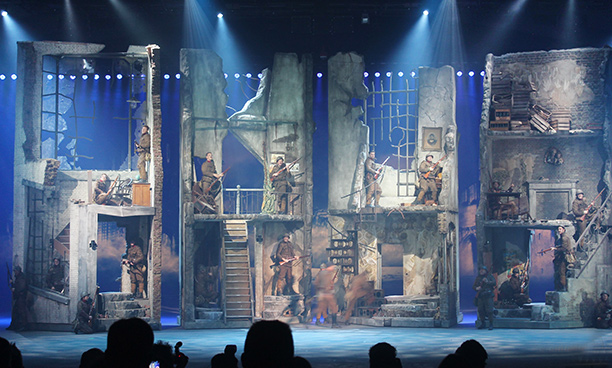
Marking the centenary of World War I, the ambitious 14-18 Spektakel musical is being staged in the Nekkerhal Mechelen in Belgium – once the largest performance space without roof pillars. With the entire 1,800-seat seating block moving along the 130m arena, a multichannel distributed sound system and automated dynamic delay-matrix processing were essential.
With the director requiring soldiers and cavalry to move cinematically towards the audience, while ground and air battles raged around and above their heads, sound designers Mark Luyckx and Guido Olischlager specified a TiMax SoundHub system for the job. The sound design also called for the theatrical equivalent of zooming in for a close-up, to create a more intimate tableau for certain scenes.
Responsible for producing the show, entertainment company Studio 100 chose a DiGiCo D5 for mixing and rigged 12 LCR rows of Coda ViRay loudspeakers along the length of the arena – which is 300m long by 60m wide – with a pair of G712 cabinets behind them.TiMax selectively switched and aligned the G712s to be either LR surrounds or foldback depending on the positions of the seating block and actors. Subbass arrays were distributed down either side of the arena with an additional eight mounted under the seating to move with the audience.
Mixing
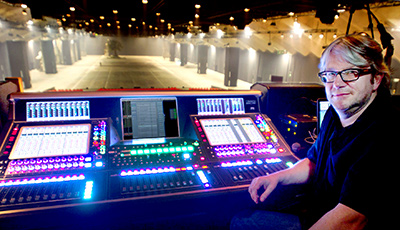
With the mobile seating and the unorthodox loudspeaker set-up, a versatile mixing console with a large I/O capacity was required.
‘We chose DiGiCo because it’s one of the favorite brands of all three audio guys involved – myself, Marc Luckx and [operator] Thomas van Hoepen,’ Olischlager says. ‘Critically, the SD5 is also one of the few digital consoles that can take this many inputs, outputs and mixes, and it can also mix surround sound, which is an important feature of this show.
‘Another advantage of the SD5 was that we could also use Optocore – because of the moving bleacher, we needed a 350m Optocore network, with optical Madi running from the TiMax system distributed to the system amplifiers.’
With 140 inputs and the SD5’s 32 input/24 output matrix used to capacity, the show places considerable demands on the mixer: ‘The SD5’s fader starts is a very nice feature for monitors in musicals, because it allows the monitor level to be a set pre-fader. When we have to bring the faders down during the show, we can do it without adjusting the monitor levels. That is a really big plus,’ Olischlager explains. ‘If you’re following post-fader and an actor talks too loud, his level goes down in the monitors and so he talks louder again to hear himself – meaning you’re fighting against each other. With the SD5, we’re setting a level for monitors and then opening and closing faders independently – no problem.’
Olischlager and his team tweaked the SD5’s software to their precise specifications with support from DiGiCo’s Netherlands distributor, Jaap Pronk of TM Audio: ‘It was very helpful to speak to Jaap, he says. ‘It meant I could speak Dutch with him and we could adjust the desk to precisely how we needed it.’
Live mics
A production that features multiple actors, moving objects and complex moving scenery, moving bleachers and even a horse on stage, meant that the mics being used were likely to pick up a lot of unwanted noise. 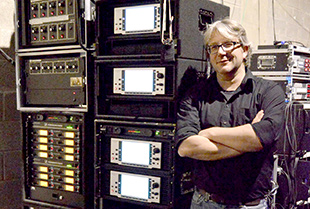 ‘If the audio is compressed, all the other sounds going on are compressed and can come down the microphone as loud as the voice you want to amplify,’ Olischlager says, explaining the choice of Sennehiser’s 9000 digital mic systems.
‘If the audio is compressed, all the other sounds going on are compressed and can come down the microphone as loud as the voice you want to amplify,’ Olischlager says, explaining the choice of Sennehiser’s 9000 digital mic systems.
‘We wanted the signal chain to be as clean as possible, with no A/D and D/A conversion to compromise the audio quality. Basically it is digital from the Sennheiser vocal microphones right through to the system amplifiers.’
In order to cover the large stage area with wireless, the Sennheiser Benelux’ technical team, who supplied the mic systems, designed a custom antenna distribution system: ‘In total, we use two directional and six omni-directional antennas – this was needed to anticipate all the required décor set-ups of the movable elements, which are massive metal reflectors in the large staging area,’ says Christophe van den Berghe Sales & Marketing Director at Sennheiser Benelux.
‘Knowing that Mechelen is situated in an area where RF traffic is very dense – including the production’s own requirements – we configured the system in such a way that we can switch in a broad spectrum, allowing us to change frequencies if needed. The Sennheiser Wireless Systems Manager (WSM) used during the production is also Mac-compatible and takes on full control of all Sennheiser wireless series.
‘I’ve done a couple of musicals with other brands and there was always trouble with the RF, but this has been great. We are doing ten shows a week and have had no drop-outs, no RF problems, no broken beltpacks, no broken mics – nothing. And the support from Sennheiser Benelux has been invaluable.’
Placing the sound
Following initial meetings with Olischlager and Steven Kemland from TiMax distributor Face.be, Out Board’s Robin Whittaker proposed eight TiMax delay-based Image Definition objects along the length of the hall for each of the LCR, LR surrounds, LR foldback and sub stems, which were fed via Madi to separate TiMax SoundHub inputs from a DiGiCo SD5 mixing console at FOH – which also travelled with the audience. 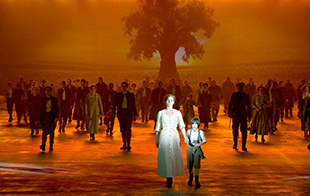 These 70-plus Image Definitions would apply independent level/delay relationships to each mix stem and the loudspeaker arrays, which would depend on the location of the audience seating at any time.
These 70-plus Image Definitions would apply independent level/delay relationships to each mix stem and the loudspeaker arrays, which would depend on the location of the audience seating at any time.
TiMax morphed the mix between these various Image Definitions as the seats moved, to continually keep the various sub-systems properly time-aligned and routed. This was fully automated using Midi program change commands triggering TiMax SoundHub cues, with the Midi coming from a Coolux Media Server receiving positional data from the seating drive mechanism. TiMax then fed the amplifiers via Madi over an Optocore fibre-optic network.
What sounds like a complex hook-up and audio showcontrol system was rendered relatively simple by the combination of TiMax Image Definitions and its TimeLine facility, which is generally used for sound effects programming. ‘The process has taken us weeks to accomplish and would have been impossible without TiMax,’ observes Olischlager.
Pre-recording
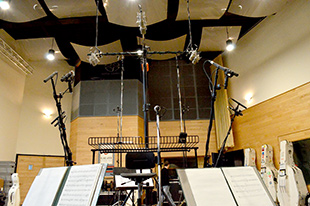 The show was originally planned with a full band playing live in an orchestra pit, but when the stage design evolved to include the moving elements, this became impractical. Instead, the orchestra and the choir were pre-recorded at Galaxy Studios in Belgium. The 70-piece Royal Flemish Philharmonic was conducted by Dirk Brossé. Galaxy Studios’ Patrick Lemmens, tonmeister and chief recording engineer, elected to use this opportunity for A/B testing a completely analogue set-up from their equipment and a digital microphone set-up supplied by Sennheiser Benelux for this purpose.
The show was originally planned with a full band playing live in an orchestra pit, but when the stage design evolved to include the moving elements, this became impractical. Instead, the orchestra and the choir were pre-recorded at Galaxy Studios in Belgium. The 70-piece Royal Flemish Philharmonic was conducted by Dirk Brossé. Galaxy Studios’ Patrick Lemmens, tonmeister and chief recording engineer, elected to use this opportunity for A/B testing a completely analogue set-up from their equipment and a digital microphone set-up supplied by Sennheiser Benelux for this purpose.
As main microphones, Lemmens used three Neumann M 150s (analogue) and three Neumann D-01s (digital) in a Decca tree set-up. Neumann KM 133 Ds and KM 183 Ds were used to add surround and height information. On the digital side, the sopt mics included KM 133 Ds for violins, viola and celli, and KM 184 Ds for the piano, timpani, woodwind overheads, and for the brass section (horns, trumpets, trombones, tuba). Sennheiser MKH 8040s were used as spot mics for the flute, oboe, clarinet and bassoon. The percussion used KM 143 Ds, an MKH 8040, KM 185 Ds and KM 145Ds.
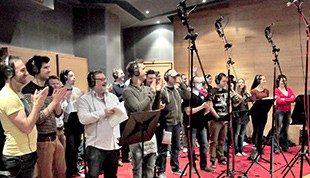 The choir was recorded in a separate room, miked by Neumann KM 133Ds and KM 184 Ds, and was fed the orchestra’s audio signal via Sennheiser HD6 Mix monitoring headphones.
The choir was recorded in a separate room, miked by Neumann KM 133Ds and KM 184 Ds, and was fed the orchestra’s audio signal via Sennheiser HD6 Mix monitoring headphones.
‘Having recorded the symphonic orchestra, choir and vocals for the 14-18 soundtrack simultaneously with more than 140 analogue and digital microphones, I was incredibly curious as to whether the digital mics could stand up against the warm sound of the analogue ones,’ Lemmens says. ‘I knew the advantages of digital to be flexibility and low noise – crucial for live situations but it’s less of an issue in a recording studio. All that matters here is sound quality. I was therefore really stunned by the excellent sonic result of the mix that was made exclusively with the 71 digital mics.’









